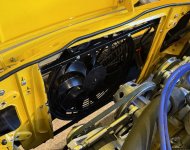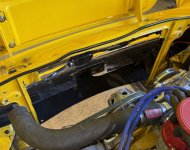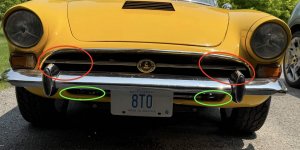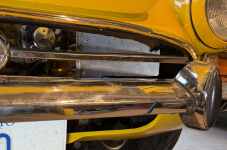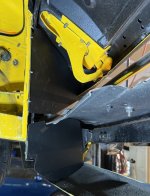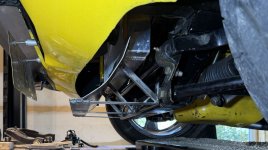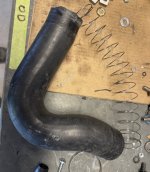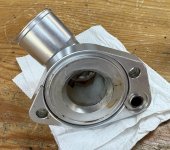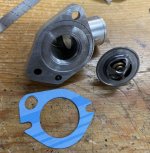Updates.
My hood vents look like the picture that Austin Healer shows; sort of an angled cutaway in front of the vent.
I have tested the 180F thermostat that I had in the car and the 160F one that I am putting in. The 160F was a little sluggish, started opening at 160F and was fully open at 170F.
It's interesting about the air having very little area to exit the engine compartment. The extensive testing that was done by those 2 guys a while ago didn't mention that being an issue at all (unless I missed that part).
What I'm doing is not what should be done to see what effect each mod has. But I'm tired of taking things apart and putting them back together and just want to drive the car. So all the mods are being done in one shot; side air deflectors to direct more air into the rad, a bottom scoop to do the same thing, opened up the flow area into the rad, put a 160F thermostat in. It is not all back together yet, so no results, but here are some of the details.
First, a dumb one. The original rad opening in the sheet metal was round. I opened up the corners to increase the flow area. I recently noticed that the rad is blocked on the sides by over an inch each side. Why I didn't notice before? Don't know. Anyways, I opened it up more.
Before:
View attachment 21244
After:
View attachment 21245
I calculated a 16% increase in flow area. That should be significant.
Then, looking at the front of the car:
View attachment 21246
The red areas don't flow into the rad. They either flow through the horn holes, or if those are blocked then the air hits a wall and I suppose finds its way into the rad....somewhat.
The green areas flow through and out to the suspension area; no cooling provided.
What I did was make some angled baffles to direct the air going into those areas to flow into the rad.
Hard to get a good picture, but this is an upper one on one side:
View attachment 21247
This is after painting the upper and lower pieces. It is hard to see in the picture that they angle out at the front, as you can see in the unpainted picture. That was done on both sides:
View attachment 21248
These block most of the horn hole air. Some will go around the front/outer part of the baffle and go into the engine compartment; maybe some cool air in there is good?
The last area was below the rad. This area was blocked a little by the lower cowl metal and a lot by the licence plate. Can't really do anything about the plate. Well, I could move it over to the side of the front, but I really don't like that look on cars. So I made a "snow plow" to direct some of the air going under the car to go into the rad:
View attachment 21249
View attachment 21250
I've since painted it black so it really won't show much. And it looks low, but the oil pan and part of the exhaust is an inch lower.
I really think all this has to make a difference in cooling while the car is in motion. At idle, not sure how much good it will do. I did find a small area above the rad where fan air was blowing over the rad, so I'll seal that up.
It is 95F here so not a lot of fun working on the car.
Rick
Edit: I'm debating putting the A/C condenser back in, in front of the rad. It didn't seem to have much of an effect on engine temperature and if I don't put it back it will be another project to mount it under the trunk with a fan and connect it all up. The baffles I've added direct air to the front of the rad, which would largely be behind the condenser. I'll put the condenser in and have a look at what the airflow will be like.

